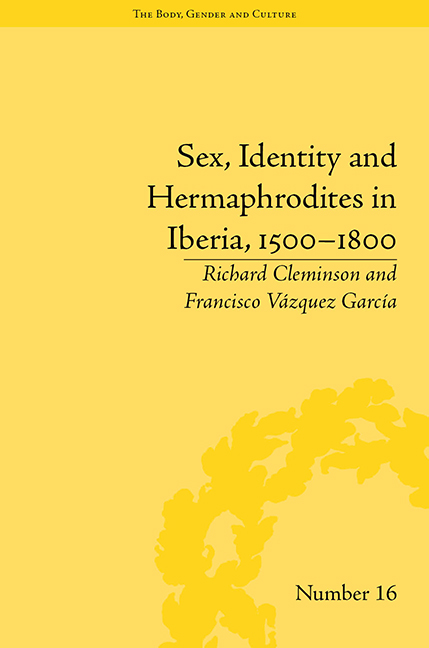Book contents
- Frontmatter
- CONTENTS
- Acknowledgements
- Introduction: Sex, Gender and Historicity
- 1 Marvels, Monsters and Prodigies: Hermaphrodites as Natural Phenomena in Spain, 1500–1700
- 2 Sexual Transgression and Hermaphroditism: The ‘New World’ and Imperial Subjectivity
- 3 The Expulsion of the Marvellous: The Decline of the ‘One-Sex’ Model, 1750–1830
- 4 Hermaphroditism in Portugal
- Conclusion
- Notes
- Works Cited
- Index
2 - Sexual Transgression and Hermaphroditism: The ‘New World’ and Imperial Subjectivity
- Frontmatter
- CONTENTS
- Acknowledgements
- Introduction: Sex, Gender and Historicity
- 1 Marvels, Monsters and Prodigies: Hermaphrodites as Natural Phenomena in Spain, 1500–1700
- 2 Sexual Transgression and Hermaphroditism: The ‘New World’ and Imperial Subjectivity
- 3 The Expulsion of the Marvellous: The Decline of the ‘One-Sex’ Model, 1750–1830
- 4 Hermaphroditism in Portugal
- Conclusion
- Notes
- Works Cited
- Index
Summary
For the period 1530–1688 testimonies corresponding to approximately twenty cases of hermaphrodites and masculinized women, mainly from Castile, have been collected, although some doubt has been cast on the occasional case (such as María/Magdalena Muñoz). This set also includes some cases of ‘sex change’, that is, of women who decided to dress like a man and live as one without undergoing any process of physical change. In our time, hermaphrodites and changes in biological sex belong to an ontological register that is completely different from simple transvestism or changing of appearance. This difference was not operational in what might be termed the ‘old sexual regime’. During that time, to have one sex was to belong to a state or a rank; biological attributes formed part of that rank, as did one's dress or the kind of occupation to which one devoted oneself.
Although the set of examples referred to above is only a proportion of any number that may exist, what is significant is that at least five of the twenty-one cases correspond to women who took religious vows. In addition, we know that at least three of these – Catalina de Erauso, Elena de Céspedes and Estebanía de Valdaracete – spent some time in the army or had something to do with the carrying of arms. Life in a convent also meant that double or alternate sexual identities were possible as such an existence implied a withdrawal from the world and from conjugal exigencies.
- Type
- Chapter
- Information
- Sex, Identity and Hermaphrodites in Iberia, 1500–1800 , pp. 41 - 64Publisher: Pickering & ChattoFirst published in: 2014

